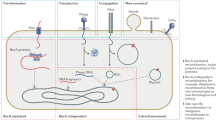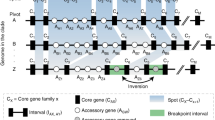Abstract
Bacterial genomes are extremely dynamic and mosaic in nature. A substantial amount of genetic information is inserted into or deleted from such genomes through the process of horizontal transfer. Through the introduction of novel physiological traits from distantly related organisms, horizontal gene transfer often causes drastic changes in the ecological and pathogenic character of bacterial species and thereby promotes microbial diversification and speciation. This review discusses how the recent influx of complete chromosomal sequences of various microorganisms has allowed for a quantitative assessment of the scope, rate and impact of horizontally transmitted information on microbial evolution.
Similar content being viewed by others
References
Achtman M and Hakenbeck R 1992 Recent developments regarding the evolution of pathogenic bacteria; inMolecular biology of bacterial infection: Current status and future perspective (ed.) C E Hormaeche (Cambridge: SGM/Cambridge University) pp 13–31
Andersson J O and Andersson S G E 1999 Insights into the evolutionary process of genome degradation;Curr. Opin. Genet. Dev. 9 664–671
Andersson S G E and Kurland C G 1990 Codon preferences in free-living microorganisms;Microbiol. Rev. 54 198–210
Andersson S G E and Kurland C G 1998 Reductive evolution of resident genomes;Trends Microbiol. 6 263–268
Aravind L, Tatusov R L, Wolf Y I, Walker D R and Koonin E V 1998 Evidence for massive gene exchange between archaeal and bacterial hyperthermophiles;Trends Genet. 14 442–444
Berg D E 1989 inMobile DNA (eds) D E Berg and M M Howe (Washington DC: American Society for Microbiology) pp 185–210
Buchanan-Wollaston V, Passiatore J E and Canon F 1987 Themob andoriT mobilization functions of a bacterial plasmid promote its transfer to plants;Nature (London) 328 170–175
Casjens S 1998 The diverse and dynamic structure of bacterial genomes;Annu. Rev. Genet. 32 339–377
de la Cruz F 2000 Horizontal gene transfer and the origin of species: lessons from bacteria;Trends Microbiol. 8 128–133
Doolittle W F 1998 You are what you eat: a gene transfer ratchet could account for bacterial genes in eukaryotic nuclear genomes;Trends Genet. 14 307–311
Doolittle W F 1999 Lateral genomics;Trends Cell Biol. 9 M5-M8
Dubnau D 1999 DNA uptake in bacteria;Annu. Rev. Microbiol. 53 217–244
Dutta C and Das J 1992 Mathematical characterization of chaos game representation: New algorithms for nucleotide sequence analysis;J. Mol. Biol. 228 715–729
Dykhuizen D E 1998 Santa Rosalia revisited: why are there so many species of bacteria?;Antoine Van Leeuwenhoek J. Microbiol. Serol. 73 25–33
Elkins C, Thomas C E, Seifert H S and Sparling P F 1991 Species-specific uptake of DNA by gonococci is mediated by a 10-base-pair sequence;J. Bacteriol. 173 3911–3913
Falkow S 1996 The evolution of pathogenicity inEscherichia, Shigella andSalmonella; inEscherichia coli andSalmonella: Cellular and Molecular Biology (ed.) F C Neidhardz (Washington DC: American Society for Microbiology) pp 2723–2729
Freiberg C, Fellay R, Bairoch A, Broughton W J and Rosenthal A 1997 Molecular basis of symbiosis betweenRhizobium and legumes;Nature (London) 387 394–401
Gemski P, Lazere J R, Casey T and Wohlhieter J A 1980 Presence of virulence-associated plasmid inYersinia pseudotuberculosis;Infect. Immun. 28 1044–1047
Goodman S D and Scocca J J 1998 Identification and arrangement of DNA sequence recognized in specific transformation ofNeisseria gonorrhoeae;Proc. Natl. Acad. Sci. USA 85 6982–6986
Grillot-Courvalin C, Goussard S, Huetz F, Ojcius D M and Courvalin P 1998 Functional gene transfer from intracellular bacteria to mammalian cells;Nat. Biotechnol. 16 862–866
Grinsted J, de laCruz F and Schmitt R 1990 The Tn21 subgroup of bacterial transposable elements;Plasmid 24 163–189
Groisman E A and Ochman H 1996 Pathogenicity islands: bacterial evolution in quantum leaps;Cell 87 791–794
Groisman E A, Saier M H Jr and Ochman H 1992 Horizontal transfer of a phosphatase gene as evidence for the mosaic structure of theSalmonella genome;EMBO J. 11 1309–1316
Hacker J, Blum-Oehler G, Mühldorfer I and Tschäpe H 1997 Pathogenicity islands of virulent bacteria: structure, function and impact on microbial evolution;Mol. Microbiol. 23 1089–1097
Hayes W S and Borodovsky M 1998 How to interpret an anonymous bacterial gonome: machine learning approach to gene identification;Genome Res. 8 1154–1171
Heinemann J A and Sprague G F J 1989 Bacterial conjugative plasmids mobilize DNA transfer between bacteria and yeast;Nature (London)340 205–209
Huynen M A and Bork P 1998 Measuring genome evolution;Proc. Natl. Acad. Sci. USA 95 442–444
Ikemura T 1985 Codon usage and tRNA content in unicellular and multicellular organisms;Mol. Biol. Evol. 2 13–34
Isberg R R and Falkow S A 1985 A single genetic locus encoded byYersima pseudotuberculosis permits invasion of cultured animal cells byEscherichia coli K-12;Nature (London) 317 19–25
Jain R, Rivera M C and Lake J A 1999 Horizontal gene transfer among genomes: the complexity hypothesis;Proc. Natl. Acad. Sci. USA 96 3801–3806
Jeffrey H J 1990 Chaos game representation of gene structure;Nucleic Acids Res. 18 2163–2170
Jiang S C and Paul J H 1998 Gene transfer by transduction in the marine environment;Appl. Environ. Microbiol. 64 2780–2787
Karlin S and Burge C 1995 Dinucleotide relative abundance extremes: a gonomic signature;Trends Genet. 11 283–290
Karlin S, Campbell A M and Mrázek J 1998a Comparative DNA analysis across diverse genomes;Annu. Rev. Genet. 32 185–225
Karlin S, Mrázek J and Campbell A M 1998b Codon usages in different gene classes of theEscherichia coli genome;Mol. Microbiol. 29 1341–1355
Karlin S, Mrazek J and Cambell A 1997 Compositional biases of bacterial genomes and evolutionary implications;J. Bacteriol. 179 3899–3913
Kranz R G and Goldman B S 1998 Evolution and horizontal transfer of an entire biosynthetic pathway for cytochrome biogenesis:Helicobacter, Deinococcus, Archae and more;Mol. Microbiol. 27 871–874
Lan R and Reeves P 1996 Gene transfer is a major force in bacterial evolution;Mol. Biol. Evol. 13 47–55
Lawrence J G 1997 Selfish operons and speciation by gene transfer;Trends Microbiol. 5 355–359
Lawrence J G 1999 Gene transfer, speciation, and the evolution of bacterial genomes;Curr. Opin. Microbiol. 2 519–523
Lawrence J G and Ochman H 1997 Amelioration of bacterial genomes: rates of change and exchange;J. Mol. Evol. 44 383–397
Lawrence J G and Ochman H 1998 Molecular archaeology of theEscherichia coli genome;Proc. Natl. Acad. Sci. USA 95 9413–9417
Lawrence J G and Roth J R 1996 Selfish operons: horizontal transfer may drive the evolution of gene clusters;Genetics 143 1843–1860
Lawrence J G and Roth J R 1998 Roles of horizontal transfer in bacterial evolution; inHorizontal transfer (eds) M Syvanen and C I Kado (London: Chapman and Hall) 208–225
Lawrence J G and Roth J R 1999 Genomic flux: genome evolution by gene loss and acquisition; inOrganization of the prokaryotic genome (ed.) R L Charlebois (Washington DC: American Society for Microbiology) pp 263–289
Martin W 1999 Mosaic bacterial chromosomes: a challenge en root to a tree of genomes;Bioessays 21 99–104
Maurelli AT, Baudry B, d’Hauteville H, Hale T L and Sansonetti P J 1985 Cloning of plasmid DNA sequences involved in invasion of HeLa cells byShigella flexneri;Infect. Immun. 49 164–171
Maurelli A T, Fernández R E, Bloch C A, Rode C K and Fasano A 1998 ‘Black holes’ and bacterial pathogenicity: a large genomic deletion that enhances the virulence ofShigella spp. and enteroinvasiveEscherichia coli;Proc. Natl. Acad. Sci. USA 95 3943–3948
Mazel D, Dychinco B, Webb V A and Davies J 1998 A distinctive class of integron in theVibrio Cholerae genome;280 605–608
McDaniel T K and Kaper J B 1997 A cloned pathogenicity island from enteropathogenicEscherichia coli confers the attaching and effacing phenotype onE. coli K-12;Mol. Microbiol. 23 399–407
Milkman R 1997 Recombination and population structure inEscherichia coli;Genetics 146 745–750
Nelson K Eet al 1999 Evidence for lateral gene transfer between Archaea and Bacteria from the genome sequence ofThermotoga maritima;Nature (London)399 323–329
Ochman H, Lawrence J G and Groisman E A 2000 Lateral gene transfer and the nature of bacterial innovation;Nature (London) 405 299–304
Pan A, Dutta C and Das J 1998 Codon usage in highly expressed genes ofHaemophillus influenzae andMycobacterium tuberculosis: translational selection versus mutational bias;Gene 215 405–413
Perez Luz S, Rodriguez-Valera F, Lan R and Reeves P R 1998 Variation of the ribosomal operon 16S-23S gene spacer region in representativeSalmonella enterica subspecies;J. Bacteriol. 180 2144–2151
Portnoy D A, Moseley S L and Falkow S 1981 Characterization of plasmids and plasmid-associated determinants ofYersinia enterocolitica pathogenesis;Infect. Immun. 31 775–782
Reanney D C 1978 Coupled evolution: adaptive interactions among the genomes of plasmids, viruses, and cells;Int. Rev. Cytol. (Suppl.) 8 1–68
Rivera M C, Jain R, Moore J E and Lake J A 1998 Genomic evidence for two functionally distinct gene classes;Proc. Natl. Acad. Sci. USA 95 6239–6244
Sasakawa C, Kamata K, Sakai T, Makino S, Yamada M, Okada N and Yoshikawa M 1988 Virulence-associated genetic regions comprising 31 kilobases of the 230-kilobase plasmid inShigella flexneri 2a;J. Bacteriol. 170 2480–2484
Sassanfar M, Kranz J E, Gallant P, Schimmel P and Shiba K 1996 A eubacterialMycobacterium tuberculosis tRNA synthetase is eukaryote-like and resistant to a eubacterial-specific antisynthetase drug;Biochemistry 35 9996–10003
Schicklmaier P and Schmieger H 1995 Frequency of generalized transducing phages in Natural isolates of theSalmonella typhimurium complex;Appl. Environ. Microbiol. 61 1637–1640
Sharp P M and Li W-H 1987 The codon adaptation index — a measure of directional synonymous codon usage bias, and its potential applications;Nucleic Acids Res. 15 1281–1295
Smith H O, Tomb I-F, Dougherty B A, Flerschmann R D and Venter J C 1985 Frequency and distribution of DNA uptake signal sequences in theHaemophilus influenzae Rd genome;Science 269 538–540
Snel B, Bork P and Huynen M 1999 Genome phylogeny based on gene content;Nat. Genet. 21 108–110
Sonea S and Paniset M 1976 Towards a new bacteriology;Rev. Can. Biol. 35 103–167
Sueoka N 1988 Directional mutation pressure and neutral molecular evolution;Proc. Natl. Acad. Sci. USA 85 2653–2657
Syvanen M and Kado C I 1998Horizontal gene transfer (London: Chapman and Hall)
Whittam T S 1996 Genetic variation and evolutionary processes in natural populationsEscherichia coli;in Escherichia coli and Salmonella typhimurium: Cellular and molecular biology, 2nd edition (eds) F C Neidhardt, R III Curtiss, J L Ingraham, E C C Lin, K B Low, B Magasanik, W S Reznikoff, M Riley, M Schaechter and H E Umbarger (Washington DC: American Society for Microbiology) pp 2708–2720
Woese C 1998 The universal ancestor;Proc. Natl. Acad. Sci. USA 95 6854–6859
Wolf Y I, Aravind L and Koonin E V 1999aRickettsiae and Chlamydiae: evidence of horizontal gene transfer and gene exchange;Trends Genet. 15 173–175
Wolf Y I, Aravind L, Grishin N V and Koonin E V 1999b Evolution of aminoacyl-tRNA synthetases-analysis of unique domain architectures and phylogenetic trees reveals a complex history of horizontal gene transfer events;Genome Res. 9 689–710
Yap W H, Zhang Z and Wang Y 1999 Distinct types of rRNA operons exist in the genome of the actinomyceteThermomonospora chromogena and evidence for horizontal gene transfer of an entire rRNA operon;J. Bacteriol. 181 5201–5209
Author information
Authors and Affiliations
Corresponding author
Rights and permissions
About this article
Cite this article
Dutta, C., Pan, A. Horizontal gene transfer and bacterial diversity. J Biosci 27, 27–33 (2002). https://doi.org/10.1007/BF02703681
Issue Date:
DOI: https://doi.org/10.1007/BF02703681




